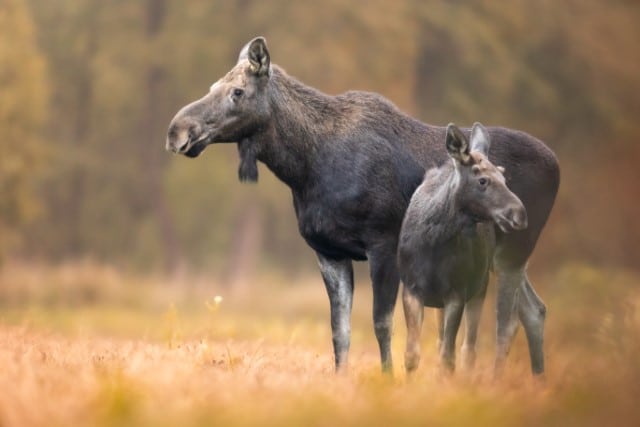An Introduction to the Female Moose
A female moose is called a cow.
You might have crossed paths with this majestic creature while hiking through the northern forests or spotted one serenely grazing in a meadow. The moose is known for its impressive size and distinct features, such as its broad antlers seen on males, called bulls. However, female moose, or cows, have their own set of characteristics that are just as fascinating.
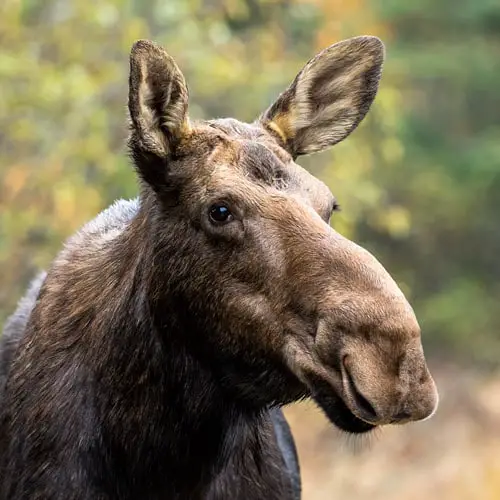
Understanding the Moose: Taxonomy and Physical Description
Recognizing the unique traits of a female moose starts with a basic understanding of moose biology.
Moose belong to the family Cervidae, which includes other well-known species such as deer, elk, and reindeer. Scientifically referred to as Alces alces, moose are the largest members of the deer family. While bulls are renowned for their antlers, cows lack these structures. Instead, they are identified by their robust body, long legs, humped shoulders, and a distinctive dewlap hanging below the throat, known as a bell.
Cows have a thick, brown fur coat that serves as insulation against cold climates. They can weigh anywhere from 500 to 800 pounds, although they tend to be smaller than their male counterparts. Female moose have a vital role to play in the moose life cycle and the maintenance of their species.
Moose Habitat and Range
The habitats of female moose are diverse but typically revolve around colder, forested environments.
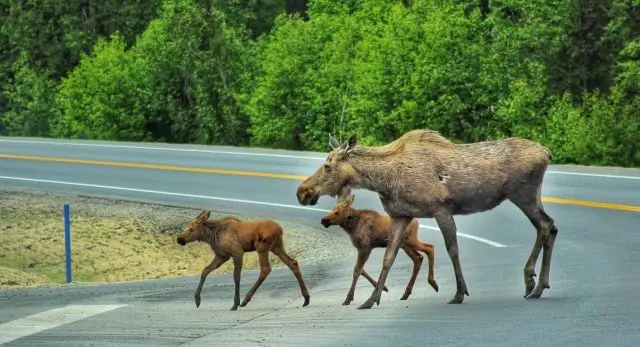
They are commonly found in the northern regions of North America, Europe, and Asia, with a preference for temperate and subarctic climates. Moose habitats are often near bodies of water like rivers, lakes, or marshes, which they use for drinking, foraging, and escape from predators. An ample supply of vegetation is essential as it comprises the bulk of a cow’s diet.
Mating and Reproduction
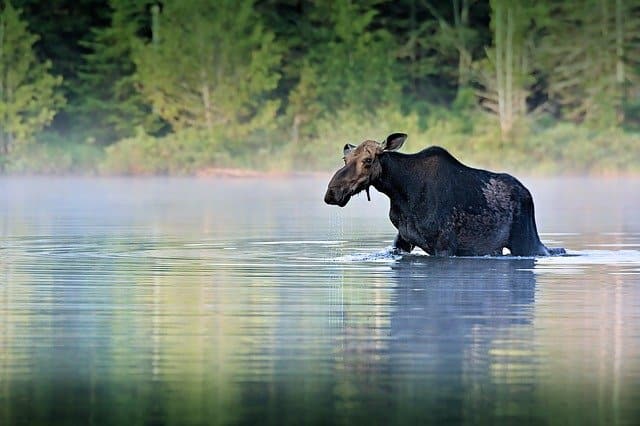
Moose cows have a specific mating period known as the rut.
The rut occurs in the fall, and during this time, cows will emit a call to attract bulls for mating. After a gestation period of approximately eight months, the cow will give birth to one or, sometimes, two calves in the spring. These calves are born with a reddish-brown fur that changes to the adult dark brown as they mature.
Role of Female Moose in the Ecosystem
Cows have a profound impact on their ecosystems.
By foraging on a wide variety of plant life, they play a significant role in shaping their habitat. This not only impacts plant distributions but can also have broader implications for other species sharing the environment. Additionally, cows provide essential nutrients to the ecosystem through their waste, contributing to a rich soil composition that benefits other flora and fauna.
Behavior and Social Structure
Understanding female moose behavior is essential for gaining insights into their social structure.
Moose are generally solitary animals, with cows only grouping with their offspring. During the first few months, the cow and her calf have a strong bond, and the cow is fiercely protective. As calves grow older and more capable of fending for themselves, they will eventually leave their mother to establish their own territories.
Human Interactions and Conservation
Female moose have been subject to both admiration and hunting by humans.
While hunting is regulated, it is still a threat to moose populations in certain areas. Additionally, habitat destruction and vehicle collisions are significant risks. Conservation efforts focus on habitat preservation, research into moose ecology, and the creation of safe passages across highways to reduce vehicle-related deaths.
Understanding Moose Behavior Through Trail Cameras
Wildlife enthusiasts and researchers often use trail cameras to observe moose behavior in their natural habitat without disturbing them.
Modern trail cameras, like the Victure Trail Game Camera, offer features such as high-resolution images, night vision, motion activation, and a robust design for all weather conditions. Reviews of the Victure camera highlight its ease of use, making it a favorite among those who want to study wildlife or simply enjoy the beauty of nature safely from a distance.
Moose Watching and Photography
Moose watching can be a peaceful and enriching experience for wildlife photographers and nature lovers alike.
Essential gear can enhance this experience, such as the Nikon Monarch 5 binoculars, which are reputed for their clear optics and durability. Moose are most active during dawn and dusk, and the Nikon Monarch 5 can help you spot a cow from a safe distance without missing any detail. The binoculars’ anti-reflective coatings ensure clarity and color fidelity, crucial for those picture-perfect moments in wildlife observation.
Frequently Asked Questions
Can climate change affect the health of female moose?
Yes, climate change can lead to increased parasite loads and affect food availability, posing health risks for female moose and their calves.
How can I help with moose conservation?
Supporting wildlife conservation organizations, participating in habitat restoration, and advocating for wildlife-friendly policies can all contribute to moose conservation efforts.
Why are female moose important for the ecosystem?
Female moose play a crucial role in shaping their habitat by foraging and contribute to the ecosystem’s overall health and diversity.
What is the difference between a male and female moose?
Male moose, known as bulls, are recognized by their large antlers, whereas female moose, or cows, do not have antlers and have a smaller body size in comparison.
What are the best practices for observing female moose in the wild?
To observe moose safely, maintain a safe distance, remain downwind, avoid making loud noises, and use optics like binoculars or cameras to minimize disturbance to the animals.
What should I do if I encounter a female moose with her calf?
If you encounter a cow with her calf, give them plenty of space. Cows can be very protective of their calves and may perceive humans as threats, possibly leading to defensive behavior.
Diet and Foraging Patterns of the Moose
The diet of a female moose is diverse and changes seasonally.
Spring and summer offer abundant vegetation, and the cow’s diet includes leaves, shoots, aquatic plants, and even flowers. During the harsher winter months, they switch to a diet of woody plants, bark, and twigs — foods that can be more challenging to digest. This foraging behavior is vital, as it provides the nutrition necessary for the cow’s health and, if pregnant, for the development of her calves.
Challenges Faced by Female Moose
Female moose face numerous challenges throughout their lives.
These include predation by wolves and bears, especially when they have young calves. Human-induced challenges are also significant, as they contend with habitat encroachment, environmental pollution, and climate change that affects their food sources. These stresses can have a considerable impact on a cow’s health and her ability to reproduce successfully.
Moose and Climate Change
Climate change has become a central issue in the survival of many species, including moose.
Warming temperatures can lead to increased parasite loads, such as winter ticks, which are particularly detrimental to the health of moose cows and their young. Climate change can also affect the availability of food resources, pushing cows to migrate to new areas in search of suitable habitat, and often leading to increased human-moose encounters.
Conservation Efforts and Research
Conservation efforts are crucial for the protection and study of moose populations.
These efforts often focus on habitat conservation, controlling hunting quotas, and studying moose behavior and ecology. Organizations and researchers use various technologies, including GPS collars, to track moose movements and gain a better understanding of their needs, aiming to develop strategies that ensure the long-term survival of these majestic creatures.
Products for Moose Enthusiasts and Wildlife Observers
Enthusiasts seeking a closer look at moose in their environment can rely on specialized products.
One such product is the Bushnell Trophy Cam Trail Camera, designed for wildlife observation and photography. It provides high-definition images and videos, is equipped with night vision, and is weather-resistant, making it ideal for prolonged outdoor use. According to user reviews, its trigger speed and battery life make the Bushnell Trophy Cam a reliable choice for capturing wildlife activity.
Find This and More on Amazon
Navigating the Ethical Considerations of Moose Hunting
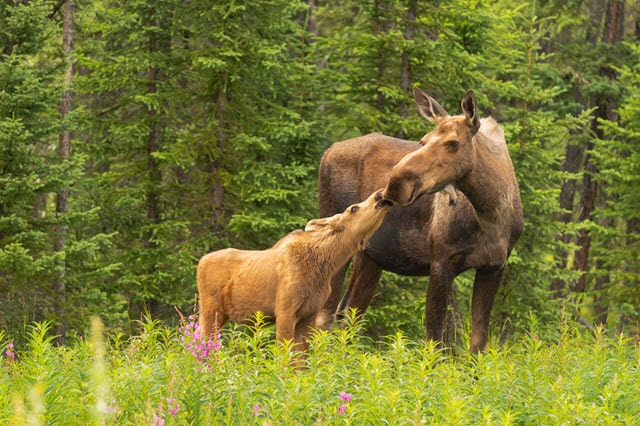
While hunting is a traditional activity, it raises ethical considerations, especially regarding female moose.
Responsible hunters abide by regulations and understand the importance of maintaining population levels. There is a special consideration for hunting cows, as they are critical to the growth of the moose population. Ethical practices involve selective hunting, avoiding mothers with calves, and respecting no-hunting zones around major conservations areas.
Integrating Moose Conservation into Education
Teaching the public about moose conservation can foster a deeper appreciation for these animals.
Education programs designed for students and the community often include information on moose biology, behavior, and the importance of conservation. These initiatives help build a culture of respect and understanding around wildlife and their essential role in our ecosystems.
Exploring Moose Populations Around the Globe
Moose are not confined to one continent, and their populations can be found around the world.
While there is a significant presence of moose in North America, particularly in Canada and the United States, populations of moose can also be found across Europe and Asia, where they are known by various names such as “elk” in British English. Exploring the different habitats and challenges of moose worldwide allows for a comprehensive understanding of their global status and conservation needs.
Moose in Culture and Native Mythology
Moose hold a special place in various cultures and mythologies.
Their powerful physical presence and solitary nature have made them a symbol of strength and independence in many Indigenous cultures. Moose are often featured in stories, totems, and artworks, reflecting their importance and sacred standing in Native mythologies.
Participate in Moose Conservation
You can play an active role in the conservation of moose.
Participating in conservation efforts can include volunteering with wildlife organizations, supporting habitat restoration projects, and advocating for policies that protect moose populations. Moreover, education about moose can help raise awareness of the threats they face, inspiring others to take action as well.
Understanding the Significance of Female Moose
The role of female moose in their ecosystems is undeniable.
As primary caretakers of their young, foragers, and maintainers of ecological balance, their health and welfare are indicators of the overall health of their environment. Sustainable practices, ethical considerations in hunting, and active conservation efforts are vital to ensure that future generations can continue to witness the magnificence of the female moose in the wild.
The Impact of Female Moose on Biodiversity
Female moose, or cows, significantly influence the biodiversity of their habitats.
By consuming various plant species, they help to maintain healthy forests and promote growth among different types of vegetation. Their movement patterns also aid in seed dispersal, contributing to the diversity of plant life in a given area. Understanding the biology of moose can provide us with more insight into their role as ecosystem engineers, shaping and sustaining the forests they inhabit.
Tracking Female Moose for Conservation Science
Science plays a crucial role in the conservation and management of moose populations.
Wildlife biologists track female moose using GPS technology to study their migration patterns, habitat preferences, and survival rates. This data is invaluable for developing effective management strategies, including targeted conservation efforts to protect these magnificent animals’ crucial habitats. For those interested in wildlife science, following the work of these conservationists can be both inspiring and educational.
Moose as a Keystone Species
Moose are sometimes considered a keystone species in their habitats.
This means they play a pivotal role in the ecological community, and their presence or absence can significantly impact the ecosystem. Female moose contribute uniquely to this balance by their foraging behavior and their role in reproducing and nurturing the next generation of moose.
Global Warming and the Future of Moose Populations
The future of moose populations is uncertain in the face of global warming.
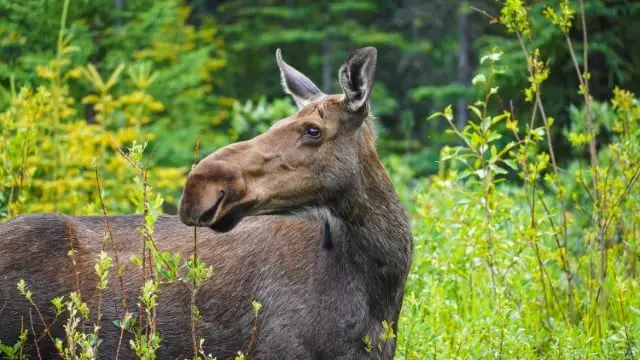
As temperatures rise, habitats change, and this can have a profound effect on the health and distribution of moose. This is particularly concerning for female moose, who need stable environments to nurture their young. Conservation efforts must therefore account for climate change, ensuring that moose populations can adapt and thrive despite environmental pressures.
Female Moose as Cultural Icons and Mascots
Cows have not only an ecological role but also a cultural significance.
These creatures are iconic symbols of wilderness and are frequently used as mascots for various organizations and sports teams. By embodying the spirit of the wild, female moose serve as ambassadors for nature conservation, reminding us of our connection to the natural world and our responsibility to protect it.
Female Moose and Ecotourism
Ecotourism initiatives often highlight female moose as draws for visitors.
Observing these animals in their natural setting can be a powerful experience and can generate revenue for conservation projects. For example, many national parks offer guided tours where you might catch a glimpse of a moose cow in her natural habitat, thereby promoting a sustainable way to appreciate wildlife while contributing to their protection.
Researching Moose Cows: Academic Studies and Findings
A wealth of academic research has been conducted on moose cows.
Studies focus on aspects such as reproductive health, the impact of environmental stressors, and interactions with other wildlife. These findings contribute to a more comprehensive understanding of moose ecology and inform conservation strategies to ensure their survival.
Integrating Technology in Moose Conservation
Advances in technology are proving invaluable in the conservation of female moose.
Drones, for instance, are used to monitor remote populations, and data analytics help identify patterns in moose behavior and health. By embracing these tools, conservationists can stay ahead of the challenges posed by an ever-changing environment.
The Role of Legislations in Protecting Moose
Laws and regulations play a crucial role in the preservation of female moose populations.
Wildlife protection acts and hunting regulations are designed to ensure sustainable populations, and ongoing legal efforts seek to adapt these laws to the changing needs of moose in different regions. Legislation is a necessary tool in the fight against habitat loss and the overexploitation of these creatures.
A Closer Look at Moose Cow Physiology
The physiological adaptations of moose cows are remarkable and have enabled them to survive in harsh climates.
Understanding their unique physiology helps us appreciate how they regulate their body temperature, store energy, and maintain their massive size. Such insights are crucial for providing the right conservation measures to support their health and longevity.
Engaging Communities in Moose Conservation
Community involvement is essential for the success of moose conservation efforts.
Local communities can participate in citizen science projects, advocate for the protection of moose habitats, and reduce human-moose conflicts. Engaged citizens can make a significant difference in the lives of these animals.
Conclusion
Female moose, or cows, are vital components of their ecosystems and hold great significance culturally and ecologically. As we have explored, their role extends far beyond their physical presence in the forests. From influencing plant life diversity to serving as ecological indicators, cows are central to the health of wildlife populations and habitats. As such, their protection through science-based conservation, community engagement, legislation, and technological innovation is crucial for preserving the natural balance and ensuring that moose, as well as numerous other species, can thrive in their natural environments.

